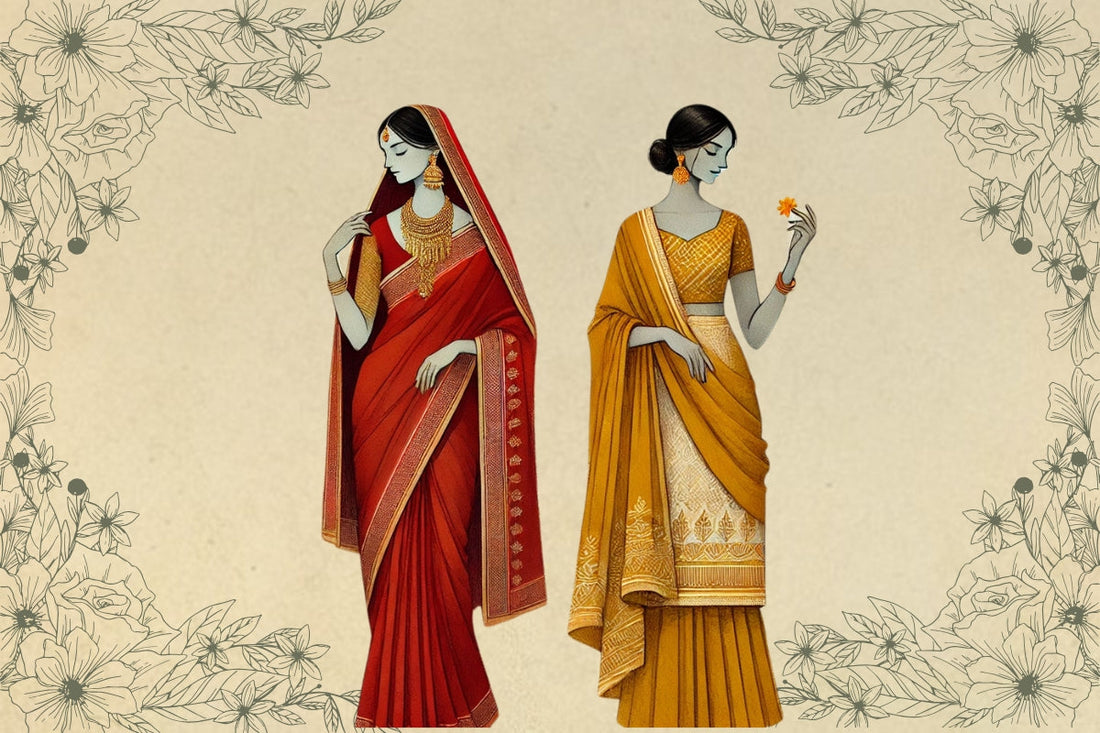
The Secret Language of Colors in Ethnic Fashion: Dressing Perfectly for Every Occasion
Share
Colors have long been a pivotal part of ethnic women's fashion, symbolizing emotions, cultural narratives, and societal roles. Across different cultures, hues are imbued with deep meanings, often dictating their usage during auspicious festivals, professional settings, and social gatherings. Drawing on scholarly insights into the philosophy and history of color in ethnic fashion, this article explores how women can effectively use colors to embody tradition, enhance occasions, and create memorable impressions.
1. Color Symbolism in Festivals
Festivals often emphasize joyous and spiritual connotations, making certain colors more suitable:
- Red: Across cultures like Indian and Chinese, red is a prominent festival color symbolizing prosperity, energy, and good fortune. Women wearing red sarees, lehengas, or salwar suits during festivals like Diwali or Lunar New Year embody vibrancy and enthusiasm.
- Gold and Yellow: Colors like gold signify wealth and grandeur, often paired with intricate designs for a regal look. Yellow, symbolizing purity and warmth, is prominent during harvest celebrations like Pongal or Baisakhi.
- White and Green: White represents peace and devotion, frequently worn during religious or purification rituals. Green, symbolic of renewal, is favored in Islamic festivities such as Eid, where embroidered green outfits are common.
2. Colors for Professional Settings
In office meetings or formal occasions, a balanced approach to colors reflects sophistication and respect:
- Navy Blue and Grey: Universally recognized as professional, these colors convey trust and authority. Incorporating ethnic elements such as a blue chikankari kurta or a grey banarasi dupatta adds cultural richness.
- Muted Earth Tones: Beige, olive, or tan tones provide a neutral yet stylish look. Women opting for muted ethnic prints or handloom fabrics exude both professionalism and cultural pride.
3. Evening Parties and Celebrations
Evening gatherings demand glamorous yet elegant hues:
- Black: Once avoided in several ethnic contexts for being inauspicious, black is now synonymous with elegance in modern ethnic wear. A black anarkali with gold embellishments makes for an exquisite choice.
- Maroon and Deep Purple: These shades project sophistication and are particularly suitable for cocktail events or festive soirées. A maroon saree with gold zari work is a timeless classic.
- Metallic Hues: Silver, bronze, and metallic blue are increasingly popular for evening gowns or Indo-western outfits, adding shimmer and contemporary flair.
4. Daytime Social Events (Brunches and Casual Gatherings)
Daylight events favor lighter, cheerful tones:
- Pastels: Peach, mint, and lavender are soft, calming, and ideal for brunches or family functions. A pastel floral kurta or lehenga adds charm without overwhelming.
- Floral Prints and Patterns: Colors combined with floral motifs resonate with natural beauty and relaxation, perfectly matching casual ethnic attire.
Cultural and Psychological Insights
Studies on color psychology emphasize the emotional resonance of colors in ethnic fashion:
- A 2022 study in Psychiatria Danubina highlights how colors like red and gold evoke optimism and positivity in traditional contexts.
- Research in the Fashion, Style & Popular Culture journal discusses the integration of historical color palettes with modern trends, underscoring their evolving significance in diverse ethnic wardrobes.
Additionally, cultural works, such as those by scholars like Blaszczyk in The Color Revolution, argue that color choices in ethnic women's fashion not only adhere to tradition but also challenge modern stereotypes of femininity and cultural identity.
Final Thoughts
Colors in ethnic women's fashion serve as more than just aesthetic choices; they are storytelling tools, connecting women to their roots while adapting to contemporary settings. Selecting the right colors for various events allows women to honor tradition, convey appropriate emotions, and make striking impressions.
In essence, whether through vibrant reds for a festival, professional blues for the workplace, or pastel tones for daytime gatherings, color choice is an art that bridges personal expression with cultural heritage.
